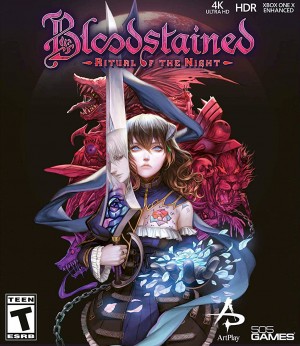Xbox One, Switch, PC
At first, Bloodstained: Ritual of the Night feels a bit staid. Though the series is new, it sees longtime Castlevania producer Koji Igarashi returning to the formula he helped define over the years with titles like Symphony of the Night. Because Bloodstained overtly draws from that tradition, the opening hours reproduce many moments fans of 2D Castlevania titles have seen before. However, this spiritual successor slowly and surely earns its keep among greats by cleverly mixing familiar elements of the genre.
The sprawling map is the cornerstone of the experience; the giant castle you explore belongs to a demented “shardbinder” named Gebel (not Dracula), and it’s enormous, winding, and a joy to uncover. As Miriam, a fellow shardbinder who can absorb the power of monsters she slays, your path can occasionally be circuitous; I often had to hoof it from a save room to a teleport room to my base of operations to stock up on supplies, then back to a save room before taking on a boss. But slowly filling out the map is a satisfying slow burn. Most areas stick to the castle’s gothic themes, but later locales introduce some fun surprises that kept me eager to see where I’d head next.
Click here to watch embedded media
You acquire new traversal abilities as you go, though this progression starts off a little slow. The double-jump won’t resolve as many loose ends on the map as you think it might, and sometimes your next destination is too vague. However, you eventually get fantastic abilities that are fun to wield and open the way forward, like a reflector beam you can use to sneak through tight spaces, or the ability to run at ridiculous speeds. By the time you’ve been through most of the map, you feel like you have total mastery of your surroundings, though later areas still provide interesting challenges.
Combat also takes a little while to come into its own. The main hook is that Miriam can equip shards that give her the powers of the monsters she kills. These initially manifest as additional attacks that cost mana or passive bonuses, but quickly offer up a number of different ways to approach combat. Do you tackle a tough area or boss by slowly healing yourself over time, or double-down on damage by creating a copy of yourself?
If you’re familiar with 2D Castlevania games, the tricks you’ve memorized (such as attacking right before you land to get an extra-fast second attack in) still work, and the familiar muscle-memory is a nice touch. But until the additional layers unravel, Bloodstained’s opening sections feel unremarkable, because encounters involve little more than ducking and weaving out of monsters’ attacks to deliver your own. Only when you start amassing interesting shards can you start exploring your options.
Click image thumbnails to view larger version
A healthy dose of RPG mechanics keeps combat exciting and give you another reason to scour every inch of the castle. As you defeat explore and level up, you find weapons with different ranges and elemental properties, as well as other equipment and items. As these different options compound on each other, I swapped between multiple shard and gear loadouts, since some weapons and skills work better against certain enemies. And while some bosses simply let you wail on them until they’re dead, others require you to learn their movements or try different builds to survive, which means being flexible and experimental with your skills.
The best equipment is locked behind extensive crafting or side-questing. This aspect can be convoluted and prone to grinding; later quests and recipes require you to farm monsters that have a low chance of dropping a particular component, and I wound up with too much stuff that didn’t seem crucial. However, once I found recipes for the most powerful weapons, I held off on finishing the game to go seek out their ingredients and craft them. The power boost you get from these items is worth the time spent acquiring them.
Bloodstained: Ritual of the Night’s journey is familiar, but the way it iterates and builds on that familiarity help distinguish it from its lineage. Its combat, RPG elements, and enticing exploration intertwine seamlessly, and had me obsessively scouring every nook and cranny of a gigantic map for hours, even after I’d defeated the last boss. I enjoyed finally returning to this haunted castle, even if it belongs to a new master.

Score: 8.5
Summary: Koji Igarashi’s return to the Castlevania formula slowly but surely earns its place in a crowded genre.
Concept: Create a new franchise that melds the action, exploration, and RPG elements that made Castlevania: Symphony of the Night successful
Graphics: Characters, monsters, and environments are colorful and distinct, though animations look stiff and clunky up close
Sound: The voice acting can be a bit stilted at times, but the music is appropriately gothic, with the occasional guitar thrown in
Playability: The accessible hack-and-slash repertoire is complemented by a flexible array of magic attacks, and Castlevania fans will find familiar tricks and maneuvers
Entertainment: Ritual of the Night starts off a little too familiar, but quickly ramps up into an impressive exemplar of the genre it’s retreading
Replay: Moderate









